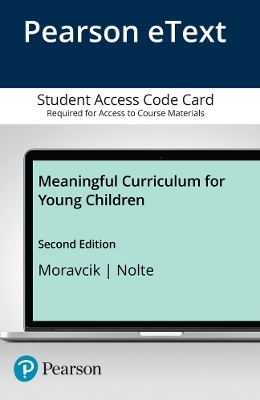
Meaningful Curriculum for Young Children -- Enhanced Pearson eText
Pearson (Hersteller)
978-0-13-448407-5 (ISBN)
- Titel z.Zt. nicht lieferbar
- Versandkostenfrei
- Auch auf Rechnung
- Artikel merken
This child-centered approach to understanding and planning curriculum focuses on humanistic and progressive education pedagogy in preschool and primary grades. The authors stress a curriculum that is joyful, has meaning to children, is built upon children's strengths, has intellectual integrity, uses developmentally appropriate pedagogy, and encourages teachers to be passionate learners along with children. The book's personal tone, many practical examples, step-by-step lesson planning process, and children's art and photographs of children bring the content to life. The new edition features updating throughout, a number of new features that add to the understanding and usefulness of the concepts, new sections on teaching curriculum to two-year-olds, and a new connection to current national subject area standards throughout.
For courses in Curriculum in Early Childhood Education.
Pearson eText is an easy-to-use digital textbook that you can purchase on your own or instructors can assign for their course. The mobile app lets you keep on learning, no matter where your day takes you — even offline. You can also add highlights, bookmarks, and notes in your Pearson eText to study how you like.
NOTE: This ISBN is for the Pearson eText access card. Pearson eText is a fully digital delivery of Pearson content. Before purchasing, check that you have the correct ISBN. To register for and use Pearson eText, you may also need a course invite link, which your instructor will provide. Follow the instructions provided on the access card to learn more.
Eva Moravcik, is Professor of Early Childhood Education at Honolulu Community College and is coordinator of the Leeward Community College Children's Center. Her publications include Who Am I in the Lives of Children? 10th Edition Pearson 2015, and Teaching the Code of Ethical Conduct: A Resource Guide 2nd Edition, NAEYC 2016. Sherry Nolte, is recently retired as Professor of Early Childhood Education at Honolulu Community College. Her publications include Who Am I in the Lives of Children? 10th Edition Pearson 2015.
Brief Table of Contents Chapter 1: Curriculum that Engages Chapter 2: Planning, Implementing, and Assessing Curriculum Chapter 3: Integrated Curriculum Chapter 4: Large Motor Curriculum Chapter 5: Fine Motor Curriculum Chapter 6: Sensory Development Curriculum Chapter 7: Language Curriculum Chapter 8: Literacy Curriculum Chapter 9: Literature Curriculum Chapter 10: Art Curriculum Chapter 11: Music Curriculum Chapter 12: Creative Movement Curriculum Chapter 13: Math Curriculum Chapter 14: Science Curriculum Chapter 15: Social Studies Curriculum Detailed Table of Contents Chapter 1: Curriculum that Engages * What is Curriculum? * Sources of Early Childhood Curriculum * What Teachers Need to Know to Plan Early Childhood Curriculum * How Early Childhood Curriculum is Organized * The Process of Designing Curriculum Chapter 2: Planning, Implementing, and Assessing Curriculum * Why do Teachers Plan? * Before You Plan * Writing an Activity/Lesson Plan * Writing Plans in the Real World Chapter 3: Integrated Curriculum * Why Integrated Curriculum? * Models of Integrated Curriculum * Designing an Integrated Curriculum Study Chapter 4: Large Motor Curriculum * Why Large Motor Curriculum? * Understanding Large Motor Development * What is Large Motor Curriculum in Early Childhood? * Teaching the Large Motor Curriculum * Large Motor Curriculum for All Children Chapter 5: Fine Motor Curriculum * Why Fine Motor Curriculum? * What is Fine Motor Curriculum in Early Childhood? * Planning Fine Motor Curriculum * Fine Motor Curriculum for All Children Chapter 6: Sensory Development Curriculum * Why Sensory Development Curriculum? * Understanding Sensory Development * What is Sensory Curriculum in Early Childhood? * Teaching Sensory Curriculum * Planning Sensory Curriculum * Sensory Curriculum for All Children Chapter 7: Language Curriculum * Why Language? * Understanding Language Development * What is Language Curriculum in Early Childhood? * Planning Language Curriculum * Language for All Children Chapter 8: Literacy Curriculum * Why Literacy in Early Childhood? * Understanding Literacy Development * What is Literacy Curriculum in Early Childhood Education? * Teaching Literacy * Planning Literacy Curriculum * Literacy for All Children Chapter 9: Literature Curriculum * Why Literature? * Literature and Development * What is Literature Curriculum in Early Childhood Education? * Teaching Literature * Planning Literature Curriculum * Literature for All Children Chapter 10: Art Curriculum * Why Art Curriculum? * Understanding Artistic Development * What is Art Curriculum in Early Childhood Education? * Teaching Art * Planning Art Curriculum * Art for All Children Chapter 11: Music Curriculum * Why Music? * Development and Music * What is Music Curriculum in Early Childhood? * Teaching Music * Planning Music Curriculum * Music for All Children Chapter 12: Creative Movement Curriculum * Why Creative Movement? * Development and Creative Movement * What is Creative Movement Curriculum in Early Childhood? * Teaching Creative Movement * Planning Music Curriculum * Creative Movement for All Children Chapter 13: Math Curriculum * Why Math? * Understanding Math Development * What is Math Curriculum in Early Childhood? * Teaching Math * Planning Math Curriculum * Math for All Children Chapter 14: Science Curriculum * Why Science? * Development and Science * What is Science Curriculum in Early Childhood? * Teaching Science * Planning Science Curriculum * Science for All Children Chapter 15: Social Studies Curriculum * Why Social Studies? * Understanding Development and Social Studies * What is Social Studies Curriculum in Early Childhood? * Teaching Social Studies * Planning Social Studies Curriculum * Social Studies for All Children
| Sprache | englisch |
|---|---|
| Maße | 216 x 279 mm |
| Gewicht | 14 g |
| Themenwelt | Sozialwissenschaften ► Pädagogik ► Vorschulpädagogik |
| ISBN-10 | 0-13-448407-X / 013448407X |
| ISBN-13 | 978-0-13-448407-5 / 9780134484075 |
| Zustand | Neuware |
| Informationen gemäß Produktsicherheitsverordnung (GPSR) | |
| Haben Sie eine Frage zum Produkt? |